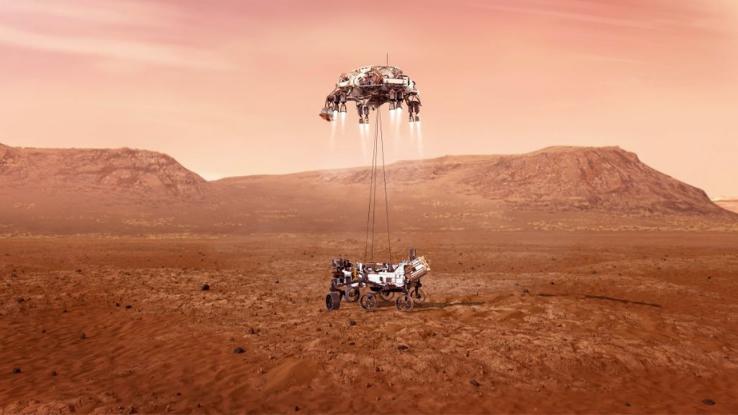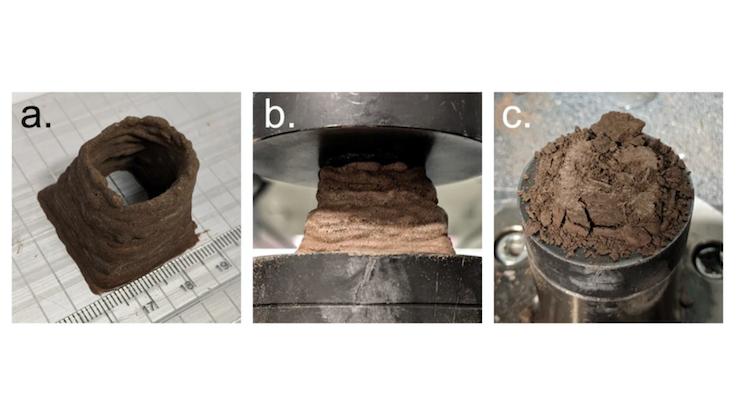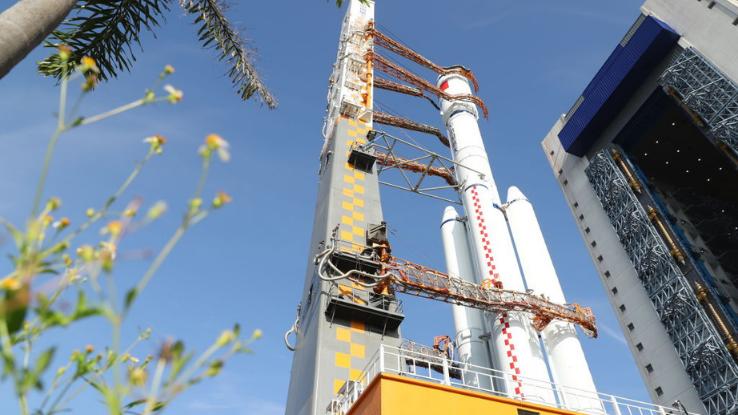Here’s How Scientists Are Using Human Blood to Build Cities on Mars

Blood, sweat and tears are often equated with difficult or impossible labor. It’s looking like it could take all three to make interstellar dreams a reality. Space travel, particularly to Earth’s neighbor, Mars, has been on the minds of scientists, politicians, philosophers, filmmakers and daydreamers for almost as long as we’ve known about the red planet.
As you read this, scientists across the globe are exploring and testing technologies to help humans along in their journey to other worlds, their growing interest partially spurred on by climate-fueled anxiety. Part of this involves working to determine just how viable living on another planet — building a new world, one that supports human life — could be.
Transporting material from Earth anywhere else in the galaxy is difficult no matter how big or small; according to MIT researcher Dr. Valentina Sumini, it would take $2 million to get a single brick to Mars. All the food and facilities that astronaut crews, let alone a permanent population, need to survive are expensive and difficult to bring into space. Scientists are realizing that, in order to build serious long-term housing in space, the materials need to exist natively on the actual planet — or they need to come from the humans that go there.
Recently, scientists have opted to explore the latter: They’ve begun experimenting with human blood to build interstellar buildings. It’s something that humans produce naturally and constantly, and, when blended with the right materials, could be used to build durable bricks for constructing buildings on Mars. This could lay the foundation for the next chapters of space exploration and colonization or usher in a new space race.
Cities on Mars Start With AstroCrete

Humans are considering building on Mars for a number of reasons. Some people are thrilled by the adventure of it all, the idea of accomplishing a feat that seems impossible. Others want to further our understanding of science and expand our limits of knowledge here on Earth. With different temperatures, gravity and landmasses, Mars is like an immersive science museum. While there’s no backup plan for the effects of climate change, looking at a different planet in the event Earth becomes uninhabitable is also a valid concern.
To inhabit Mars, humans will need to find a way to withstand subzero temperatures and wind speeds beyond 100 miles per hour. And we’ll have to build something to live in. It’s no easy feat, but part of the solution may lie within us. The use of substances our bodies produce has been the subject of several breakthrough studies, including recent research from The University of Manchester published in the multidisciplinary science journal Materials Today Bio.
Before the results of the study were published, scientists had been experimenting with a substance called “regolith” — essentially “spacedust” and broken rocks. We know from robotic explorations of the moon and Mars that the substance can be found in both places. Only recently has regolith been thought of as a building block for a settlement. But because it’s dust, it needs to be combined with other materials to become usable.
Here’s where human blood comes in: Roberts’ and his colleagues’ Materials Today Bio study found that blood makes an excellent binding agent with regolith. There’s a protein in blood plasma called human serum albumin that, when combined with regolith, creates a hard substance that can protect space explorers from the radiant sun rays in places like Mars and the moon. The substance is called AstroCrete. It’s like concrete — space concrete.
The process of making AstroCrete is similar to when a river hits the right type of rock to make clay. Forming AstroCrete requires high heat to bind the blood and regolith together. However, instead of having to fire the bricks in a kiln, scientists predict the ability to 3D print the bricks, so any donated blood would function like ink.
Roberts’ study found that it will take a lot of blood to make even just one house on Mars. The scientist and his team predict that a six-person crew could produce 500 kilograms of blood in a two-year mission. Optimistically, one crew of six would be able to build enough to house that crew and another future crew of six, so one person could create enough AstroCrete to house people on Mars. These findings are early, but their potential implications could be huge. Plenty more research needs to be done before Mars construction using AstroCrete becomes a reality.
Original image by A.D. Roberts et al. – Materials Today Bio, CC BY 4.0
AstroCrete Is a Surprisingly Medieval Approach

Regolith’s potential as a brick and mortar-type material is still a relatively new subject scientists are exploring. But, conceptually, it’s not all that new. Protein-bound concrete started to take off after a 2014 Stanford study. The process required a lot of energy, and still does, but the 3D printing process may be cutting that down. In 2018, the idea of using solar powered 3D printing to make bricks became feasible. Adding blood to the mix makes the bricks stronger — but this idea isn’t a new one by any means.
Roberts told the University of Manchester more about the origin of the study, explaining that “a major challenge of the space race may have found its solution based on inspirations from medieval technology.” This refers to the use of animal blood as an ingredient in mortar centuries ago. Researchers know that ancient Chinese and Roman societies both used blood to harden mortar when building structures; it was durable and highly adhesive. Records from 18th and 19th century France and England also show blood was used in flooring and for waterproofing. The use of human blood in AstroCrete is the culmination of hundreds of years of construction knowledge.
In addition to blood, the role of urine in fortifying AstroCrete has also been studied. Roberts et al. found that urea could make their human blood bricks even stronger. Humans produce that, too, so it might eventually play a role in future space endeavors. On the plus side, when making the bricks, a fertilizer is also created, which could lead to future farming on Mars. The downside is that it took Cape Town scientists eight days to make a brick.
The Drawbacks of AstroCrete in the Quest for Mars Colonization

A trip to Mars with our current technology would take about seven months. Serious proposals to visit the red planet have been in the cultural landscape since the 1940s. Elon Musk’s SpaceX plans to send its first robotic vehicles to Mars in 2024 and 2026, and there are already robots exploring Mars from the U.S. and other countries. It’s only a matter of time before people start to directly interact with the planet.
But there’s still a lot to overcome before AstroCrete becomes viable. Because it does take so long to travel to space, it’s not hard to wonder if building bricks from blood will be harmful to astronauts. Space travel takes a toll on the body. According to NASA, space explorers suffer from slow bone loss and muscle loss. Muscle loss can be especially harmful if an astronaut isn’t eating well. Life in space is already incredibly taxing on astronauts’ bodies when they’re in space and getting proper nutrition. And losing blood while exploring space could make it even harder for their bodies to perform basic functions.
This technology is so new that there are still other technologies we need to figure out to make traveling to Mars more viable. Seven months is too long of a voyage. Spacesuits, the food astronauts eat, and maintaining the human body for so many months in space still needs to be figured out.
NASA may be sending people to Mars as early as 2037. China predicts sending people to space by 2033. Russia’s hope is to send people to Mars between 2040 and 2045. Breakthroughs in technology could speed this process up very quickly. On the other hand, climate disasters, electrical meltdowns or severe internet issues could put us off course. It may be some time before we get to Mars — if ever. Remember that whenever you reach for the stars, physically or metaphorically, the power to get to Mars is inside of us all.





